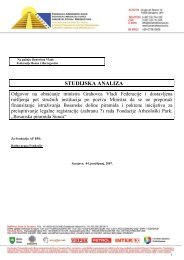The Complete Guide To Mysterious Beings - Galaksija
The Complete Guide To Mysterious Beings - Galaksija
The Complete Guide To Mysterious Beings - Galaksija
Create successful ePaper yourself
Turn your PDF publications into a flip-book with our unique Google optimized e-Paper software.
TWO<br />
”THE UGLIES AND THE NASTIES”<br />
Approximately one million head of cattle die each year from the bites of vampire bats in Central<br />
and South America, according to a research project financed by the United Nations and the Mexican<br />
government. <strong>The</strong> little bats carry and spread rabies, and it is believed that at least sixty human<br />
beings have suffered from the disease in the last fifteen years because of the creatures' nocturnal<br />
blood lapping.<br />
Vampire bats are among the more mundane monsters in our catalog of Unbelievables. <strong>The</strong>y're little<br />
fellows, rarely measuring over three inches long, with an average wingspread of eight inches. <strong>The</strong>y<br />
look something like deformed mice with wings, and they have a set of tiny, razor-sharp teeth so<br />
well-honed they can make a deft incision into human flesh without their victim even being aware of<br />
it. Since their throats are too small to swallow solid particles of food, they are obliged to live on<br />
blood.<br />
When it strikes, the little bat settles on the neck or flank of a cow, makes a small, expert incision<br />
into the animal's flesh, and proceeds to lick up the blood that flows forth. It does not such the blood.<br />
Scientists believe that the bat's saliva contains an anticoagulant, which keeps the blood flowing<br />
even after the nasty little fellow has had his dinner. (Various types of leeches also apply an<br />
anticoagulant for this purpose, and the tiny lesions they create can bleed for hours afterwards.) <strong>The</strong><br />
vampire bat is a greedy character and will lap up blood until his small body is nearly spherical.<br />
<strong>The</strong>n he clumsily spreads his wings and flutters off to his cave to sleep it off.<br />
Human victims are nearly always bitten in the toes. Explorers and peasants in the back hills of<br />
Central America frequently wake up in the morning to find their feet, which had been sticking out<br />
from under the sheets – if they were using sheets – covered with blood. It is very rare for the victim<br />
to actually feel the bat's presence. Usually the wound is completely painless. Occasionally the bats<br />
will take a nip out of other exposed parts of the body – the arms, the legs. But they very seldom<br />
attack the human neck or face.<br />
Unconfirmed (uninvestigated) rumors appear from time to time claiming that swarms of rabid bats<br />
have openly attacked villages and plantations, swarming over people like locusts and killing them<br />
or driving them mad.<br />
Well-known scientists and explorers, such as the late Dr. Raymond Lee Ditmars of the American<br />
Museum of Natural History, have invaded the caves of vampire bats and brought back live<br />
specimens for study. So we know these things definitely exist. Some Type B scientists speculated<br />
that the many vampire legends of central Europe may have been spawned by an influx of vampire<br />
bats in the Middle Ages. However, those legends seem to be completely unrelated to the tiny bats<br />
and deserve separate study.<br />
Some five thousand feet below the surface of the oceans there lurks another tiny creature with a<br />
vampirish reputation. In their infinite wisdom, scientists have labeled it Vampyrotouthis infernalis,<br />
the vampire of hell. This is a little black monstrosity about two inches long with red eyes an inch in<br />
diameter, a mouthful of sharp white teeth, ten squirming tentacles, and hundreds of glowing lights<br />
all over its minute body. It is a mollusk, distant relative of the fearsome octopus. Since it lives in the<br />
tremendous pressures of the great depths, we do not know too much about its life cycle and habits,<br />
but it is clearly a miniature carnivore which probably gobbles up anything of comparable size that<br />
comes its way. Hundreds of these creatures have been caught by appalled fishermen, and Yale's<br />
Bingham Oceanographic Laboratory has studied them.<br />
<strong>The</strong> Vampyrotouthis infernalis is a minor example of the strange and infinite variety of life forms<br />
which exist hidden away from us at the bottoms of the oceans.<br />
Our splendid planet is seething with all kinds of strange animals and plants in dire need of a good<br />
press agent. Some, like the redoubtable gooney birds of the Pacific, cannot quite make up their










